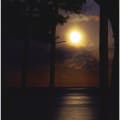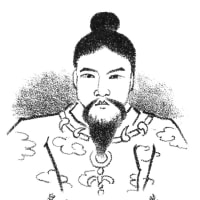『日本書紀』皇極天皇 20
冬十一月、蘇我大臣蝦夷・兒入鹿臣、雙起家於甘檮岡。呼大臣家曰上宮門、入鹿家曰谷宮門。谷、此云波佐麻。呼男女曰王子。家外作城柵、門傍作兵庫。毎門、置盛水舟一、木鉤數十、以備火災。恆使力人持兵守家。大臣、使長直於大丹穗山造桙削寺。更起家於畝傍山東、穿池爲城、起庫儲箭。恆將五十兵士、繞身出入。名健人曰東方儐從者。氏々人等入侍其門、名曰祖子孺者。漢直等、全侍二門。
四年春正月。或於阜嶺、或於河邊、或於宮寺之間、遙見有物而聽猨吟。或一十許、或廿許。就而視之物便不見、尚聞鳴嘯之響、不能獲覩其身。舊本云。是歲、移京於難波、而板蓋宮爲墟之兆也。時人曰、此是伊勢大神之使也。
≪英訳≫
In the winter of the eleventh month, Soga no Ōomi Emishi (蘇我大臣蝦夷) and his son Iruka (入鹿) built their residences side by side on Mount Umakashi (甘橿岡). The residence of the Ōomi (大臣) was called Ue no Mikado (上宮門), while Iruka’s residence was called Hazama no Mikado (谷宮門). The word hazama (谷) was pronounced hasama (波佐麻) at that time. Their sons and daughters were referred to as Ōji (王子, princes and princesses).
They surrounded their residences with stockades, built armories beside the gates, and placed large water vessels at each gate along with dozens of wooden hooks to prepare for fires. Strong men were always stationed to guard the residences, armed with weapons. The Ōomi ordered Naga no Atai (長直) to build Hokonuki-dera (桙削寺) on Mount Ōniho (大丹穂山). Furthermore, he constructed another residence to the east of Mount Unebi (畝傍山), dug a pond to serve as a defensive moat, and built storehouses to stockpile arrows. He was constantly accompanied by fifty armed soldiers, who served as his personal guards whenever he left or entered his residence. These warriors were called Azuma no Shitobe (東方儐従者, Eastern retainers).
People from various clans served at the gates of the residence and were called Oya no ko Warawa (祖子孺者, “Children of the Ancestors”). The Aya no Atai (漢直), a group of naturalized Chinese immigrants, were assigned exclusively to guard both residences.
In the fourth year, in the first month of spring, something was seen in the distance—sometimes on the ridges of hills, sometimes by the riverside, and sometimes among the palace temples. Along with these sightings, the sound of howling, like that of monkeys, was heard. Sometimes there were around ten such noises, at other times twenty. But when people approached to see what it was, the figures disappeared, leaving only the lingering echoes of cries in the air. No one was able to catch sight of the beings themselves.
An old record states that this year marked the relocation of the capital to Naniwa (難波), and that this was an omen foretelling the ruin of the Itabuki no Miya (板蓋宮, Itabuki Palace). The people of the time said, “This is a messenger of the Great Deity of Ise (伊勢大神).”
≪この英文の和訳≫
十一月、蘇我大臣(そがのおおおみ)蝦夷(えみし)とその子入鹿(いるか)は、甘橿岡(うまかしのおか)に並んで邸宅を建てた。大臣の邸を上宮門(うえのみかど)と名づけ、入鹿の邸を谷宮門(はざまのみかど)と呼んだ。なお、「谷(はざま)」は当時「波佐麻(はさま)」と発音された。彼らの息子や娘たちは「王子(おうじ)」と称された。
彼らは邸の周囲を柵で囲み、門のそばには兵器庫を設けた。さらに、各門ごとに大きな水桶を備え、木の先に鉤をつけたものを数十本置き、火災への備えとした。また、屈強な者に武器を持たせ、常に邸の警備に当たらせた。大臣は長直(ながのあたい)に命じて、大丹穂山(おおにほのやま)に桙削寺(ほこぬきのてら)を建立させた。さらに、新たに邸を畝傍山(うねびやま)の東に建て、池を掘って防御のための堀とし、兵器庫を設けて矢を蓄えた。そして、五十人の兵士を常に従え、護衛させながら出入りした。これらを力人(ちからびと)として東方の従者(あずまのしとべ)と言った。
また、諸氏の人々はこの邸に仕え、「祖子孺者(おやのこ わらわ)」と呼ばれた。漢直(あやのあたい)の者たちは、専ら二つの邸の門を警護する任務を負った。
四年春一月、ある時は丘陵の稜線に、ある時は川辺(かわべ)に、ある時は宮寺(みやでら)の間に、遠く何かが見え、猿がうめくような声が聞こえた。その数は、ある時は十ほど、またある時は二十ほどであった。人々が近づいて確かめようとすると、姿は消え、ただ鳴き嘯(うそぶ)く音だけが響き渡った。その正体を目にすることはついに叶わなかった。
古い記録には、この年、都が難波(なにわ)へ遷されたことが記されており、これは板蓋宮(いたぶきのみや)が荒廃する前兆であったとされる。人々は、「これは伊勢大神(いせのおおかみ)の使いである」と語り合った。
令和7年3月24日(月) 2025















